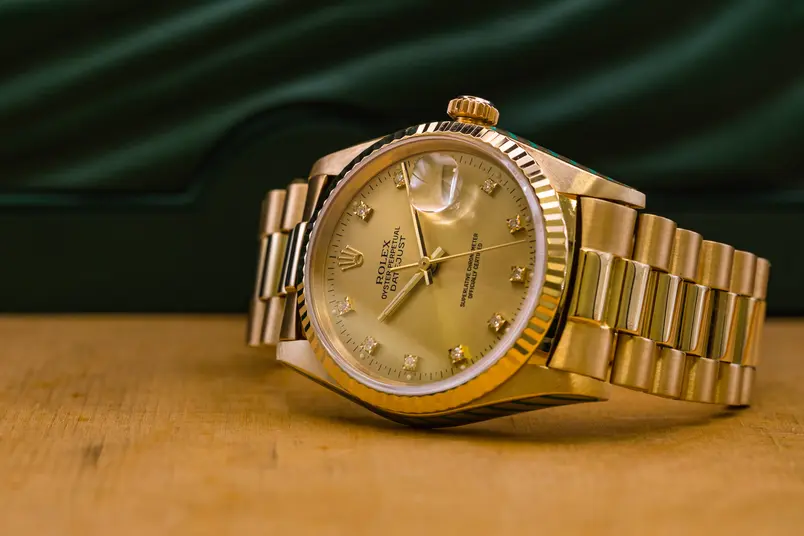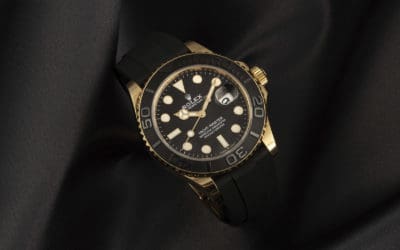Hans Wilsdorf – The Exceptional Man Behind Rolex
Hans Wilsdorf moved to London in 1904, bringing with him Wilsdorf Davis watchmakers. Feeling uncomfortably Germanic during World War I, Wilsdorf relocated his business to Geneva changed the name to The Rolex Watch Company Ltd in 1915.
Wilsdorf the team at Rolex spent the inter-war years crafting perfecting their chronographs, from the first water- dustproof watch, the Oyster, in 1926 the world’s first self-winding ‘Perpetual Movement’ watch in 1931 to stress testing Rolex with Sir Malcolm Campbell as he reached speeds of over 300 miles on the salt flats of Utah in 1935.
With the event of the Datejust, the first self‑winding wrist chronometer, coming towards the end of the Second World War, the Rolex brand had to first make it through the war which came of something as a shock, following their previous success.
Stranded Switzerland – World War Two
Import export grew increasingly difficult for Swiss-based companies during World War II, Rolex included. With an Allied victory looking more likely than not, Rolex found their route to market literally cut off when a Vichy train line was severed. With only Axis territories surrounding the Swiss watchmakers Wilsdorf unwilling to let go of his Allied market, he devised a plan that was just as audacious as many of the wartime triumphs over adversity.
Backing the Allied Forces, Wilsdorf made the offer of a Rolex to British officers in Nazi war camps who may have lost or had their watches taken from them. In a conditional offer, Wilsdorf stated that the watches would not have to be paid for until the war was over. Officers could request their watch of choice, writing via the Red Cross which, like Rolex, was based in Geneva. The Rolex of choice would be returned with a note confirming that the recipients should ‘not even think of settlement during the war.’ These notes were often handwritten by Wilsdorf himself.
The Great Escape – Rolex
Popular, many officers accepted the offer. While they were a morale boost, the watches would also prove useful in many escape attempts – particularly the escape from PoW camp, Stalag Luft III, the inspiration for the Steve McQueen film, ‘The Great Escape’.
While Flight Lieutenant Gerald Imeson did not escape in the breakout, he was instrumental in dispersing the soil from the tunnel digging by scattering handfuls through holes in his trouser pocket. Imeson wore his Rolex Oyster Chronograph throughout his march across Germany, in winter 1945, to escape the incoming Russian forces. Successfully making it home, Imeson settled his Rolex bill, for SFr.250 (£15 12s 6d) in 1947. His Rolex was sold at auction in 2013 for £30,000.
Wilsdorf was taken by a request for a stainless-steel Rolex Oyster 3525 Chronograph, identical to Imeson’s from Clive James Nutting, a Corporal in the Royal Corps of Signals, who was in the same camp. He stated that he was willing to pay for the watch with money earned in his role as camp shoemaker. While Nutting was not a commissioned officer, Wilsdorf admired his request for the more expensive Rolex 3525 Oyster chronograph, rather than the more cost-effective Rolex Speed King model.
Rolex – The King of Watches, King of Hearts
With over 3,000 watches requested by British military prisoners in one camp, Oflag VII B, alone, Wilsdorf’s plan was a resounding success. Why he did it has never been totally ascertained. A wily businessman or a humanitarian?
It had taken Rolex 40 years to sell 100,000 chronographs, selling 50,000 alone in the single year before it hit its 100,000 milestone. Wilsdorf offered the 100,000 Rolex produced – a Rolex Datejust in pink gold – to Churchill. The 150,000th Rolex was offered to Dwight D. Eisenhower. Both men accepted.
However, Wilsdorf knew he was taking a gamble that the watches may never be paid for. Yet, without Rolex chasing for payment, every bill was settled with the bills of those who lost their lives often paid by relatives.
World War Two Rolex at Auction
Some Rolex that survived WWII perform particularly well at auction, because of the story attached to the watch. A watch, belonging to a German frogman, would sell for over £52,000 at auction over 70 years later, in 2018.
The frogman had just placed charges in an attempt to blow up the bridge over the Rhine at Nijmegen. German forces have already successfully taken the bridge at Arnhem, the basis for the Hollywood film, ‘A Bridge Too Far’.
Leaving the river at the wrong point, the frogman was captured by Sgt George Rowson. Rowson took the frogman at gunpoint relieved him of his Rolex.
And what a Rolex it was – the Rolex Panerai.
The frogman’s watch was only one of only 618 Rolex 17 Panerai 3646 watches produced between 1941 1943. Made by Italian watchmaker, Panerai, using Rolex movements, this waterproof watch with an oversized face which was visible in the dark had been supplied to the Royal Italian Navy used by divers operating human torpedoes. Once owned by an Italian diver, they gifted their watches to their German counterparts, which is why the German diver was wearing one during his 1944 capture.





